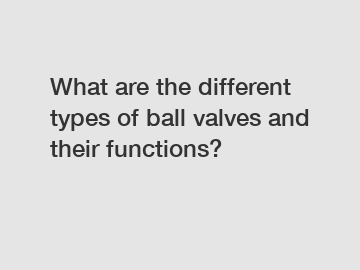Jan. 08, 2024
Agriculture
For more information, please visit Toparts.
What are the different types of ball valves and their functions?
Ball valves are widely used in various industries for controlling the flow of fluids. They are named after the spherical ball inside the valve that has a hole through it. When the hole aligns with the inlet and outlet ports of the valve, the flow is allowed, and when the ball is rotated to block the ports, the flow is stopped. There are different types of ball valves, each designed for specific applications and functions.

One type of ball valve is the full-port ball valve, also known as a full-bore ball valve. As the name suggests, it has a larger ball and port size, allowing unrestricted flow. This type of ball valve is commonly used in applications where minimal pressure drop and maximum flow capacity are required. Its larger flow path helps in reducing turbulence and pressure loss.
Another type is the reduced-port ball valve, also referred to as a standard-port ball valve. It has a smaller ball and port size compared to the full-port valve. This design reduces the flow capacity, but it also results in a more compact valve. Reduced-port ball valves are suitable for applications where flow capacity is not a critical factor, and space constraints are a concern.
The third type is the V-port ball valve. It has a V-shaped ball, which creates a precise flow control characteristic by regulating the flow through the valve. This design allows for more accurate flow control, making it suitable for applications that require precise control over the flow rate. V-port ball valves are commonly used in industries such as chemical processing, oil and gas, and power generation.
There is also the trunnion-mounted ball valve. Unlike the floating ball design, the ball in a trunnion-mounted ball valve is supported by trunnion bearings. This design provides additional support to the ball, allowing it to withstand higher pressures and larger sizes. Trunnion-mounted ball valves are commonly used in larger pipelines and higher-pressure applications.
The choice of ball valve type depends on the specific application requirements. Factors such as flow capacity, pressure rating, temperature, media compatibility, and control precision influence the selection process. Additionally, the material of construction for the valve body and ball, such as stainless steel, brass, or PVC, also plays a significant role in determining the suitability for different applications.
In conclusion, understanding the different types of ball valves and their functions is crucial when selecting the most appropriate valve for a particular application. The availability of various ball valve designs allows for versatile application in different industries. Selecting the right type of ball valve ensures optimal flow control, enhances system efficiency, and contributes to the overall success of the fluid handling process.
Please visit our website for more information on this topic.
Want more information on slab gate valve vs gate valve? Feel free to contact us.
Previous: Why should you buy roll-top welded mesh fence panels for secure commercial spaces?
Next: What are the benefits of a stainless steel water tank?
If you are interested in sending in a Guest Blogger Submission,welcome to write for us!
All Comments ( 0 )